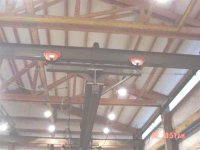aczlan
Good Morning
- Joined
- Mar 7, 2008
- Messages
- 17,540
- Tractor
- Kubota L3830GST, B7500HST, BX2660. Formerly: Case 480F LL, David Brown 880UE
Looks even better. Stencil the capacity on the fish plate with a black diamond border. With an electric hoist you're inclined to add a whole system to spool the wire as it travels which could be the most difficult part of the whole job.
Not really. Run a piece of 3/16s aircraft cable parallel to the tracks (but as tight to the ceiling as possible) and get a bunch of cheap little pulleys, fasten your power cable to the pulleys every 2' or so. Do the same thing for the trolley but run it along the top if the Ibeam and fasten it every foot.
Aaron Z

